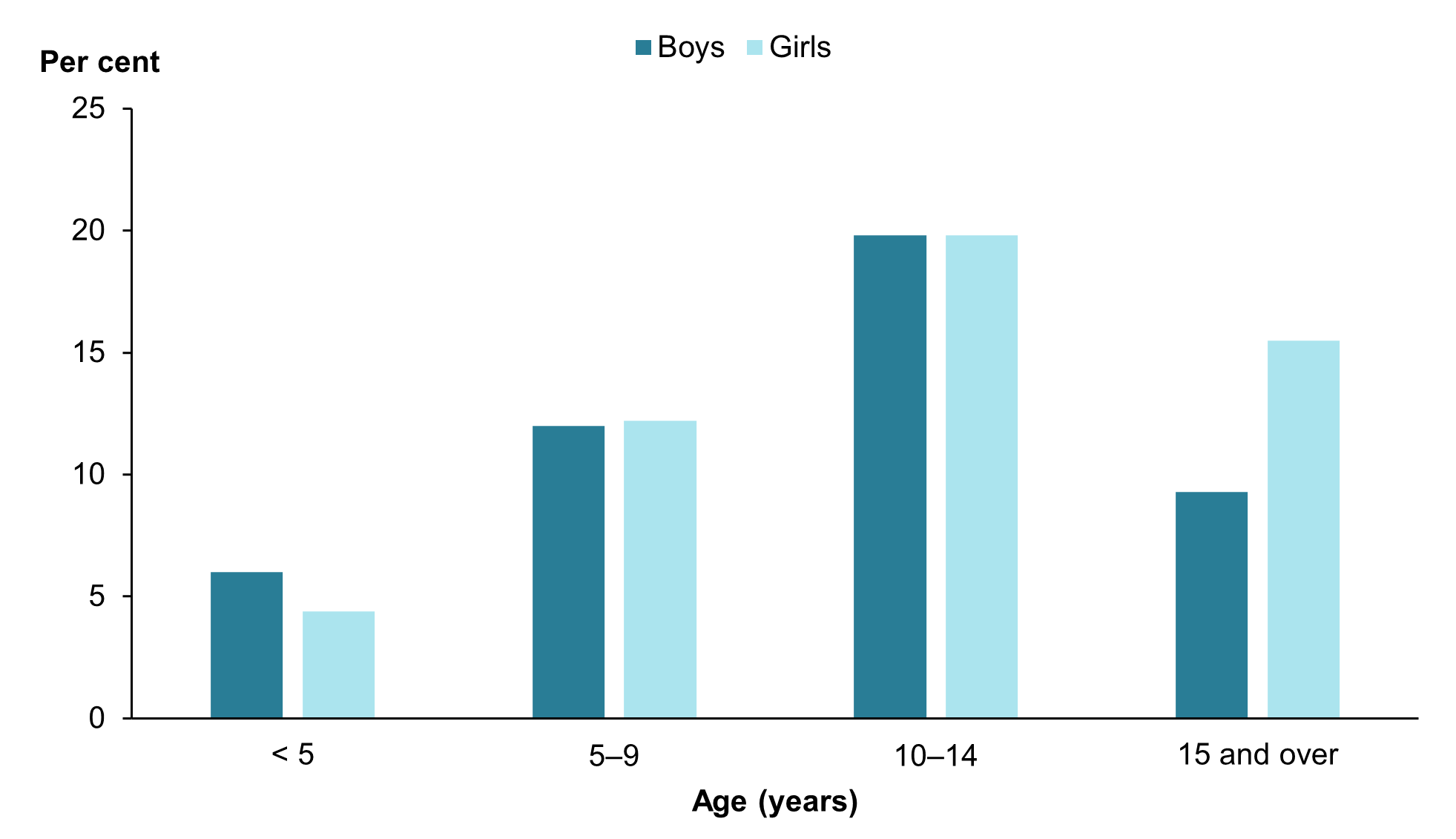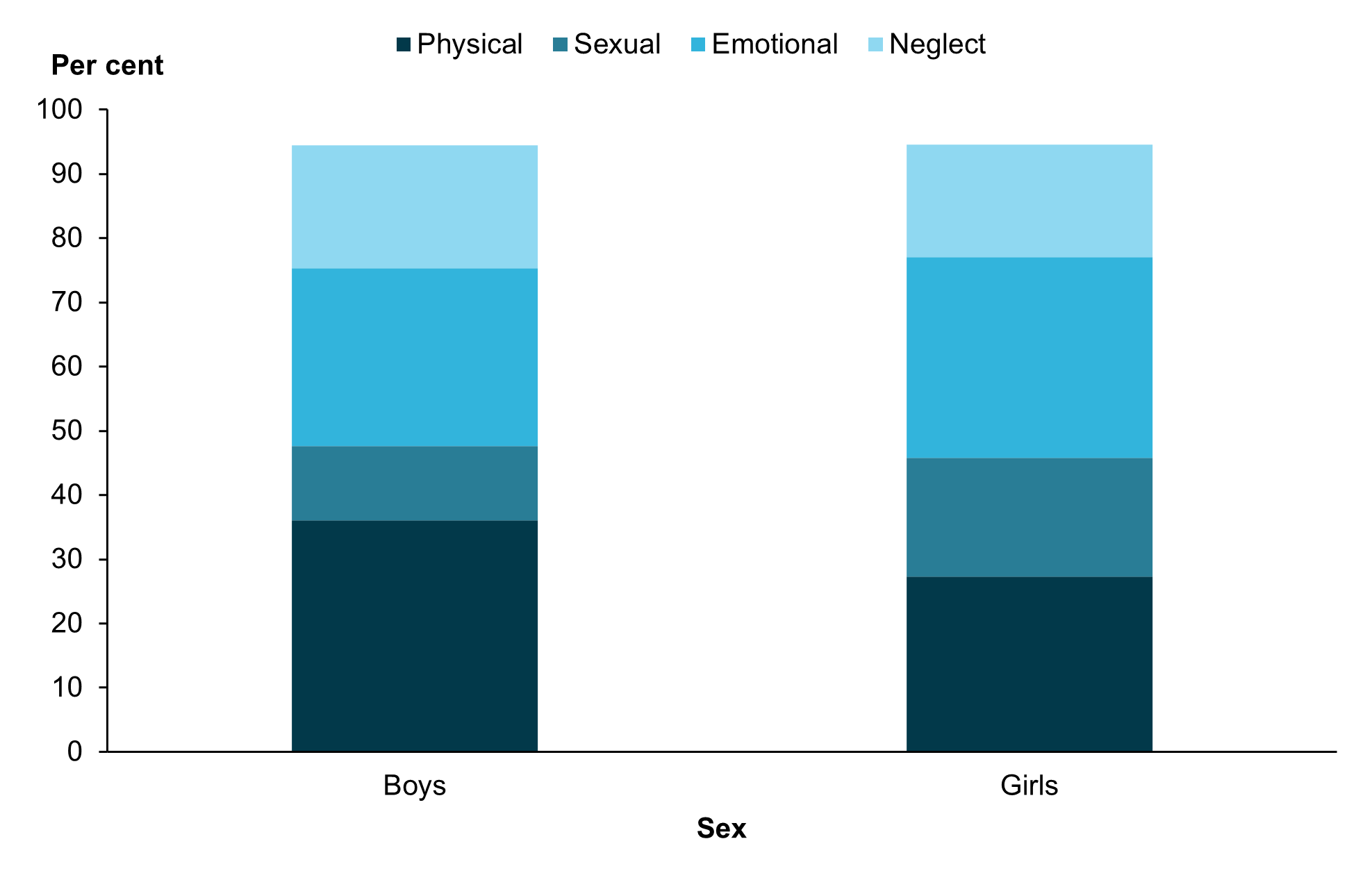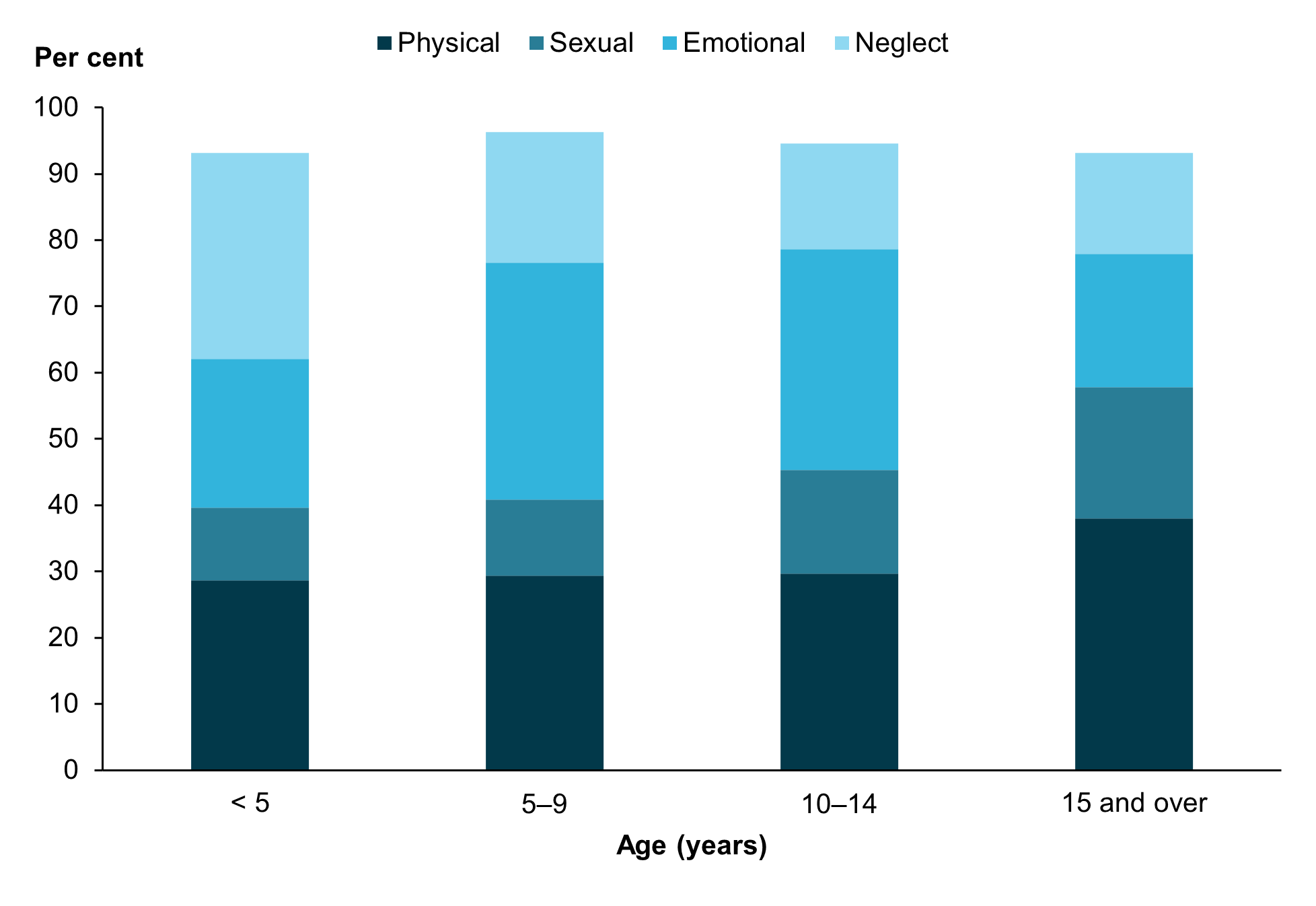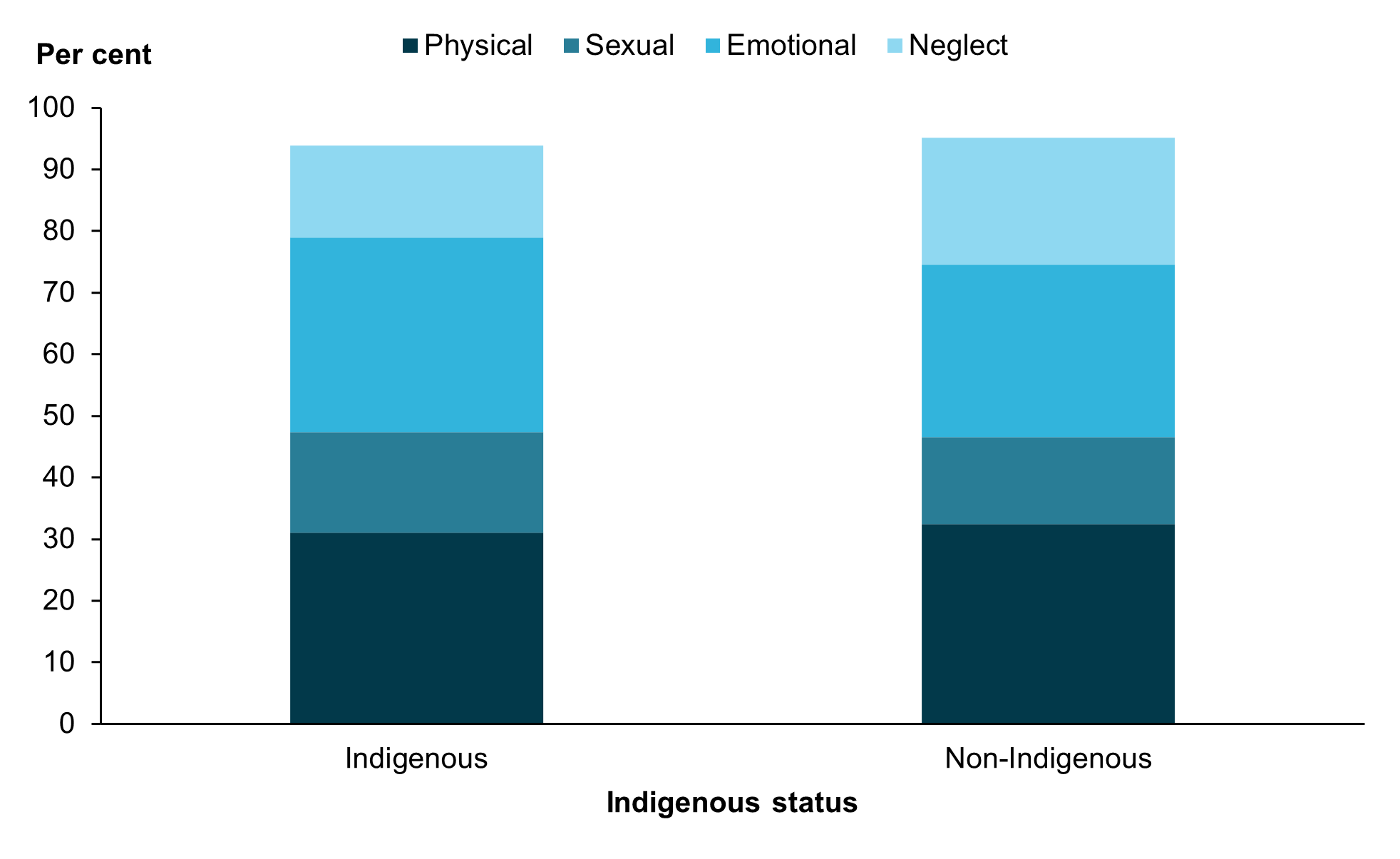How many children were abused in care?
In 2021–22, about 1,200 children in Australia were the subject of a substantiation of abuse in care. Of these children:
- 52% (640) were girls and 47% (580) were boys
- 46% (570) were Aboriginal and Torres Strait Islander
- 40% (495) were aged 10–14 at the time of substantiation.
Sources: Supplementary data tables S9.2, S9.5 and S9.6.
The number of children abused in care in the youngest and oldest age groups differed between boys and girls.
- More than half (57% or 74) of children aged under 5 who were abused in care were boys, compared with 43% (55) who were girls.
- Girls (61% or 190) aged 15 and over were more likely to be abused in care than boys (37% or 110) in the same age group (Figure 1).
Source: Supplementary data table S9.7.
Similar proportions (about 50%) of boys and girls aged 5–9 and 10–14 were the subject of a substantiation of abuse in care.
- For children aged 5–9 who were the subject of a substantiation of abuse in care, about 150 were boys and about 150 were girls.
- 245 boys and 245 girls aged 10–14 were the subject of a substantiation of abuse in care (Figure 1).
Source: Supplementary data table S9.7.
Figure 1: Children who were the subject of a substantiation of abuse in care, by age and sex, 2021–22

Note: Age is based on the child’s age on the date the substantiation was recorded, not age at the time the abuse occurred. As such, the ’15 and over’ category may include children who were under 18 at the time of abuse, but were aged 18 and over at the time of substantiation.
Source: Supplementary data table S9.7.
Type of abuse
The type of abuse presented in this section is the ‘primary’ type of abuse or neglect – the type of abuse that is considered most likely to place the child at risk or be most severe in the short term.
In 2021–22, physical abuse was the most common primary type of abuse for all children in care (32% or about 390), followed by emotional abuse (29% or about 365).
Source: Supplementary data table S9.3.
For boys (580), the most common forms of abuse were:
- physical abuse (36% or 210)
- emotional abuse (28% or 160).
For girls (640), the most common forms of abuse were:
- emotional abuse (31% or 200)
- physical abuse (27% or 175).
Sexual abuse was more common among girls (19% or 120) than boys (12% or 65), while neglect was similar among boys (19% or 110) and girls (18% or 115) (Figure 2).
Source: Supplementary data table S9.6.
Figure 2: Children who were the subject of a substantiation of abuse in care, by type of abuse and sex, 2021–22

Note: Total includes children whose sex was not stated or recorded as ‘intersex or indeterminate’, and children whose abuse type was not stated. As such, the subcategories may not sum to 100%.
Source: Supplementary data table S9.6.
The most common type of abuse varied across age groups.
- Emotional abuse was most common among those aged 5–9 (36% or 110) and 10–14 (33% or 165) at the time of substantiation.
- Neglect was most common among children aged under 5 (31% or 40).
- Physical abuse (38% or 120) and sexual abuse (20% or 62) were most common among those aged 15 and over (Figure 3).
Source: Supplementary data table S9.5.
Figure 3: Children who were the subject of a substantiation of abuse in care, by type of abuse and age, 2021–22

Notes:
- Total includes children whose abuse type was not stated. As such, the subcategories may not sum to 100%.
- Age is based on the child’s age on the date the substantiation was recorded, not age at the time the abuse occurred. As such, the ’15 and over’ category may include children who were under 18 at the time of abuse, but were aged 18 and over at the time of substantiation.
Source: Supplementary data table S9.5.
The incidence of primary types of abuse was similar for Aboriginal and Torres Strait Islander children (570) and non-Indigenous children (660).
- Emotional abuse (32% or 180) and physical abuse (31% or 175) were the most common types of abuse among Aboriginal and Torres Strait Islander children.
- Physical abuse was the most common type of abuse (32% or 215) for non-Indigenous children, followed by emotional abuse (28% or 185).
- Sexual abuse was similar among Aboriginal and Torres Strait Islander children (16% or 93) and non-Indigenous children (14% or 93).
- Neglect was slightly more common among non-Indigenous children (21% or 135) than Aboriginal and Torres Strait Islander children (15% or 85) (Figure 4).
Source: Supplementary data table S9.4.
Figure 4: Children who were the subject of a substantiation of abuse in care, by type of abuse and Indigenous status, 2021–22

Note: Total includes children whose Indigenous status was not stated, and children whose abuse type was not stated. As such, the subcategories may not sum to 100%.
Source: Supplementary date table S9.4.
Rate of abuse among all children in care
Currently, it is not possible to estimate the rate of abuse among all children in care because:
- data are based on the date of substantiation (not date of abuse) so may include historical cases of children who were in care at the time the abuse occurred, but subsequently exited care before the date of the substantiation. This may mean it is not possible to identify a directly comparable numerator and denominator for use in rate calculations. It may only be feasible to identify a ‘best estimate’ of all children in the in-care population to use as a denominator
- abuse in care substantiations data include children in out-of-home care, and children on selected types of court orders who may be in other (non-out-of-home care) living arrangements. Currently, there are no readily available data on other living arrangements. Data are readily available for the out-of-home care population, however, this is a narrower scope than the abuse in care substantiations data (so any comparisons may overestimate the rate of abuse in care).


